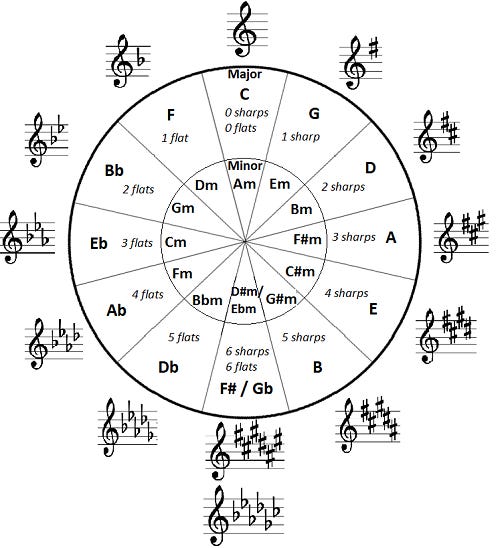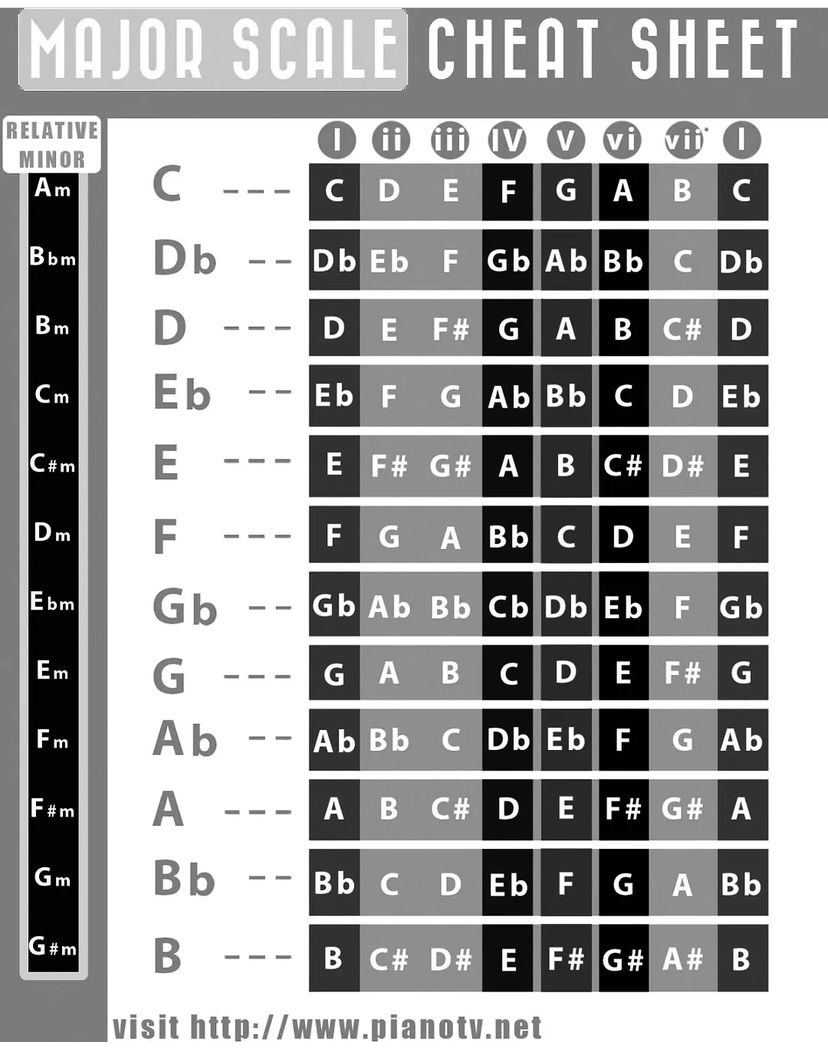Charts Today And a New Post Tomorrow!!
What’s on the I-35 horizon?
Last week’s Bonus Round: The subtitle question was “What Do You Say?”, and the answer is, nothing at all, as in “When You Say Nothing At All”, a beautiful song by an equally beautiful singer, Alison Krauss, and her band, Union Station. The song, written by Paul Overstreet and Don Schlitz, was originally a hit by Keith Whitley, and featured on his album, “Don’t Close Your Eyes”. Ms. Krauss, with Union Station, covered it on the album “Keith Whitley: A Tribute Album”, a compilation album by featuring several artists in 1995 and later that year on Ms. Krauss’ album “Now That I've Found You: A Collection”.
Today, I’m including a couple of charts that readers who are guitarists may find helpful. For new subscribers (thank you so much!!), checking out this post from last October might be a good review of what a “capo” is and how it can make your early journey with the guitar a little easier. Fair warning, that’s where we start our descent into the dreaded topic of music theory, but I try to make that as painless as possible through the context of how music theory is a “language” among musicians. That post and the ensuing series that ran through November covered a lot of the basics of music theory as a language and may be a good refresher. You can find them all in the archive
Here’s a handy chart I put together to give a quick reference for placing the capo so you can play easier chord shapes while remaining in the song’s original key.
Capo conversions using the chord shapes for these keys:
I ii iii IV V *vi vii°
G: G Am Bm C D Em F#°
C: C Dm Em F G Am B°
D: D Em F#m G A Bm C#°
_______________________________________
Capo on 1
Use Play
Chord New
Shape Key I ii iii IV V vi vii°
G = Ab Ab Bbm Cm Db Eb Fm G°
C = Db Db Ebm Fm Gb Ab Bbm C°
D = Eb Eb Fm Gm Ab Bb Cm D°
Capo on 2
Use Play
Chord New
Shape Key I ii iii IV V vi vii°
G = A A Bm C#m D E F#m G#°
C = D D Em F#m G A Bm C#°
D = E E F#m G#m A B C#m D#°
Capo on 3
Use Play
Chord New
Shape Key I ii iii IV V vi vii°
G = Bb Bb Cm Dm Eb F Gm A°
C = Eb Eb Fm Gm Ab Bb Cm D°
D = F F Gm Am Bb C Dm E°
Capo on 4
Use Play
Chord New
Shape Key I ii iii IV V vi vii°
G = B B C#m D#m E F# G#m A#°
C = E E F#m G#m A B C#m D#°
I ii iii IV V vi vii°
D = *Gb(F#) Gb Abm Bbm Cb(B) D Ebm F°
Capo on 5
Use Play
Chord New
Shape Key I ii iii IV V vi vii°
G = C *C Dm Em F G Am B°
C = F F Gm Am Bb C Dm E°
D = G *G Am Bm C D Em F#
The way you use this (and feel free to cut and paste it - though you may need to check the formatting if you paste it into a word processing app) is:
First, determine the key the song you want to learn is written in. Do this in several ways (it’s always good to check more than one way). First, if the first chord, and the last chord in the song match, it’s an indicator the song is written in the key that uses that chord as the “tonic”; the “I” chord. You can also see if the song is on the Chordify app, and use the “Export to PDF” function (3 dot menu, upper right corner) to view the signature information. Count the sharps (#) or flats (b) in the key signature and check the Circle of Fifths chart for the key that corresponds. If the key is CMaj, GMaj or DMaj, you should be able to play the chords in those keys on the first 3 or 4 frets of your guitar.
If it’s not one of the “cowboy chord” keys, determine which key it is in, then check the right side of the capo conversion chart, find the key, and place the capo at the fret indicated (you actually place the capo immediately “behind” - on the headstock side- the actual metal fret). Just count down from the nut by fret, the first one you come to is Fret 1, and so on. Remember, while you’re playing the “shapes” of one key, the chords you’re playing are actually the chords of a different key. Telling a vocalist, pianist/keyboardist, drummer (who doesn’t really care anyway) or other instrumentalist that you’re capoed and playing different shapes will at best earn you a puzzled look. They really only care that you’re in the same key they are and those keys are on the right side of the chart above.
Notes: in the section above the line (the Keys of GMaj, CMaj, and DMaj, note the asterisk by the “vi” - it’s there because the “vi” chord of a Major scale is the I chord of the relative minor of the Major key. That’s the chord the relative minor “starts” on, the “tonic” or root of the minor key that’s “relative” to the Major key. Our old friend, the Circle of Fifths, also shows this:
See the inner ring labeled “Minor”? That’s the relative minor key root. We’ll talk more about minor keys in the future.
While we’re on the asterisks, note the asterisk by the Gb/F# in the Capo 4 section. All the other “flat” keys (Ab, Bb, etc) will probably be referred to as flats. You’ll often hear Gb referred to as F#. Note the Circle of Fifths and as the chart shows, the notes of the chords are the same (F# equals Gb), it’s just said that way more often.
Finally, note the asterisks at the shapes of CMaj and GMaj when capoed on the 5th fret. Those are shapes you can play without a capo at the top of the fretboard in those keys. So the most important thing about capoing on 5 is if you are playing a song written in FMaj and you want the simpler “C” shapes. The only other reason would be to play a song in CMaj or DMaj at a higher pitch, perhaps to emulate the sound of a mandolin or ukelele.
Finally, here’s a simpler chart with all the chords in all the Major keys listed:
I like how it’s called a “cheat sheet”, as if my old brain might actually memorize all of that. Nope, I’m happy to be cheatin’ and winning.
So, lots of charts today, but there’s a reason for that. Tomorrow we’re going to learn how to chord chart in a different style, called “Nashville notation”. It’s not that much different than the Roman numerals denoting each chord, but if you need to make a key change in a relatively simple chord progression of a chord chart on the fly, it’s a lot quicker, and that cheatin’ Major Scales chart above might come in handy.
Here’s a collection of links to some articles for vocalists - and singing the songs you’re rehearsing as you play (even if you don’t sing during performances) is a good thing for guitarists:
Bonus Round: First thing you see in this town…
See you tomorrow!!
Cheers, and keep playing!!
Michael Acoustic





Love these charts! I always just rely on the shapes when capoing, without worrying what notes I'm actually playing. I'd like to get better at that. Appreciate it!